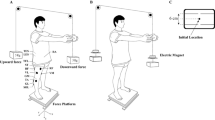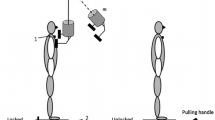Summary
EMG responses, vertical and A-P shear forces and kinematics of “automatic postural responses” to unexpected translational perturbations in the headward and tailward directions were studied in cats. Muscles acting on the major joints of the forelimbs and hindlimbs were studied. Movement of the animals in response to perturbation were highly stereotyped and consisted of two phases: (1) motion of the feet during platform movement while the trunk remained relatively stationary followed by (2) active correction of posture by movement of the trunk in the direction of perturbation.
Vertical force changes occurred after the perturbation was well underway (latency 65 ms) and were related to the displacement of the center of mass and active correction of trunk position. Shear forces showed both passive (inertial) and active components and suggested that the majority of the torque necessary for po,stural correction was generated by the hindlimb.
EMG responses in forelimb and shoulder muscles were most correlated with increase in vertical force, showing a generalized co-contraction in tailward translation (when these limbs were loaded) and little activity when the forelimbs were unloaded.
EMG responses in hindlimb showed reciprocal activation of agonists and antagonists during perturbation with strong synergies of thigh and foot flexors in tailward translation and thigh and foot extensors in headward translation. The forelimb EMG patterns were most consistent with the conclusion that the forelimb is used primarily for vertical support during perturbation.
It was concluded that hindlimb EMG responses were appropriate for both vertical support and performance of the postural correction. The hindlimb muscle synergies observed during translation are the “mirror image” of those observed in humans by other workers.
Similar content being viewed by others
References
Brookhart JM, Mori S, Reynolds PJ (1970) Postural reactions to two directions of displacement in dogs. Am J Physiol 218: 719–725
Brookhart JM, Parmeggiani PL, Petersen WA, Stone SA (1965) Postural stabilization in the dog. Am J Physiol 208: 1047–1057
Coulmance M, Gahery Y, Massion J, Swett JE (1979) The placing reaction in the standing cat. A model for the study of posture and movement. Exp Brain Res 37: 265–281
Crouch JE (1969) Text atlas of cat anatomy. Lea and Febiger, Philadelphia
Dufosse M, Macpherson J, Massion J (1982) Biomechanical and electromyographic comparison of two postural supporting mechanisms in the cat. Exp Brain Res 45: 38–44
English AW, Letbetter WD (1981) Intramuscular “compartmentalization” of the cat biceps femoris and semitendinosus muscles: Anatomy and EMG patterns. Neurosci Abstr 7: 557
English AW, Letbetter WD (1982) Anatomy and innervation patterns of cat lateral gastrocnemius and plantaris muscles. Am J Anat 164: 67–78
Loeb GE (1979) Chronic peripheral nervous system physiology. In: Humphrey D (ed) Electrophysiological techniques, a short course. Soc Neuroscience Bethesda Md, 167–194
Massion J, Swett JE, Coulmance M, Gahery Y (1975) Postural adjustments associated with a placing movement. Exp Brain Res [Suppl] 23: 137
Miller S, van der Berg J, van der Meché FGA (1975) Coordination of movements of the hindlimbs and forelimbs in different forms of locomotion in normal and decerebrate cats. Brain Res 91: 217–237
Mori S, Brookhart JM (1968) Characteristics of the postural reactions of the dog to a controlled disturbance. Am J Physiol 215: 339–348
Mori S, Reynolds PJ, Brookhart JM (1970) Contributions of pedal afferents to posture control in the dog. Am J Physiol 218: 726–734
Nashner LM (1976) Adapting reflexes controlling the human posture. Exp Brain Res 26: 59–72
Nashner LM (1977) Fixed patterns of rapid postural responses among leg muscles during stance. Exp Brain Res 30: 13–24
Rushmer DS, Russell CJ (1981) Responses to controlled postural disturbance in the cat. Neurosci Abstr 7: 689
Rushmer DS, Roberts WJ, Augter GK (1976) Climbing fiber responses of cerebellar Purkinje cells to passive movement of the cat forepaw. Brain Res 106: 1–20
Author information
Authors and Affiliations
Additional information
Supported by NIH grants NS02289 and RR05593 as well as Good Samaritan Hospital and the Medical Research Foundation of Oregon
J. Macpherson was supported by a Canadian MRC fellowship
Rights and permissions
About this article
Cite this article
Rushmer, D.S., Russell, C.J., Macpherson, J. et al. Automatic postural responses in the cat: Responses to headward and tailward translation. Exp Brain Res 50, 45–61 (1983). https://doi.org/10.1007/BF00238231
Received:
Revised:
Issue Date:
DOI: https://doi.org/10.1007/BF00238231




